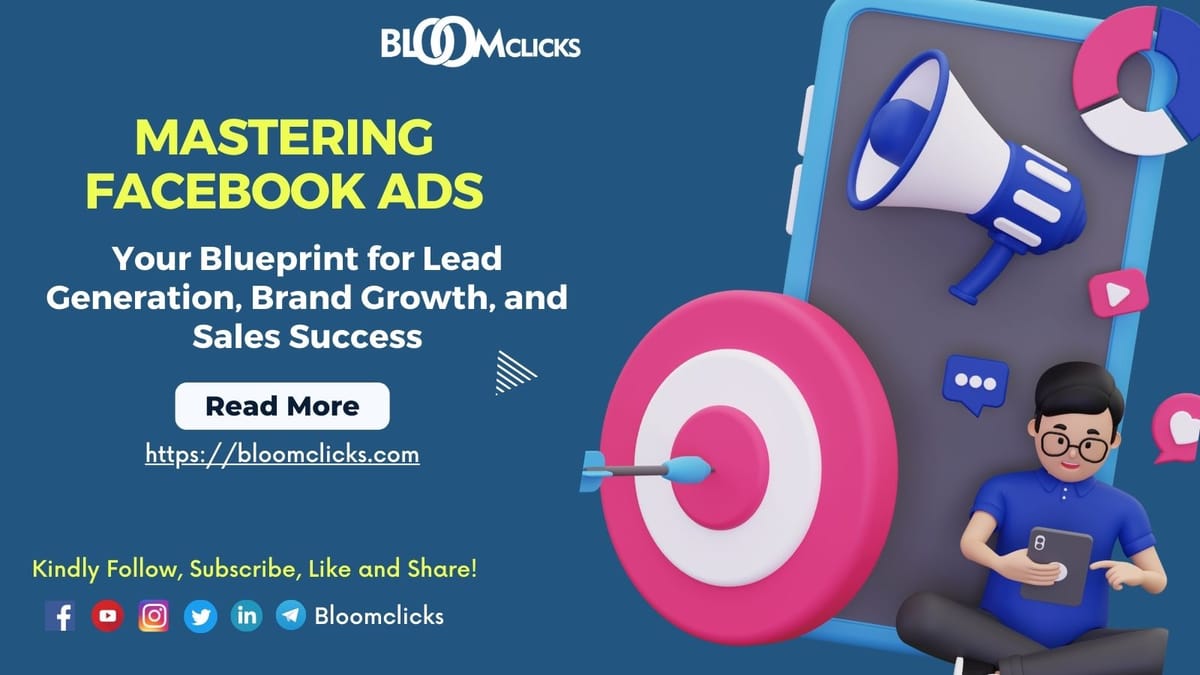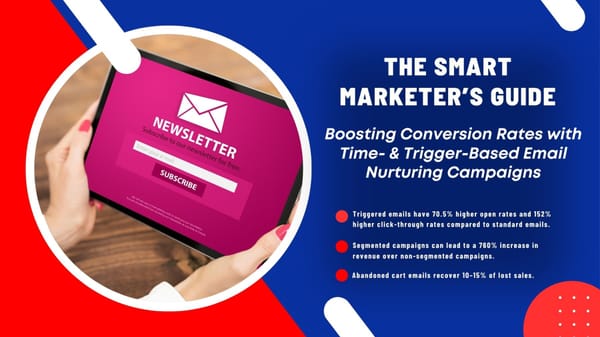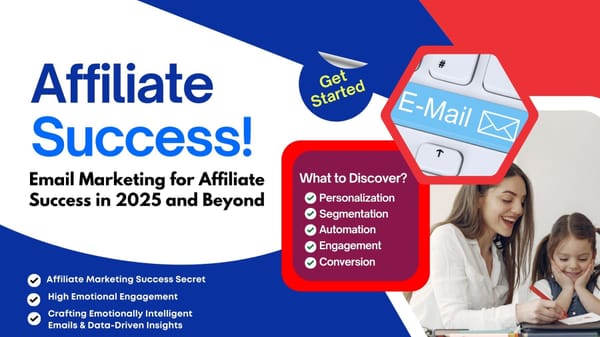Unleashing the Power of Facebook Ads: A Comprehensive Guide to Generating Leads, Building Brand Awareness, and Driving Sales

In today's hyperconnected world, where digital platforms serve as the primary battleground for businesses vying for consumer attention, Facebook stands out as a beacon of opportunity. What began as a simple social networking site has evolved into a dynamic marketing powerhouse, offering businesses unparalleled access to a global audience of billions. At the heart of Facebook's transformative journey lies its advertising platform – a sophisticated ecosystem that empowers businesses to connect with their target audience, drive engagement, and achieve their marketing objectives with precision and efficacy.
In this comprehensive guide, we embark on a journey to demystify Facebook Ads – from understanding the evolution of the platform to choosing the right objectives for your campaigns, optimizing ad performance, and overcoming common challenges. Whether you're a seasoned marketer looking to refine your strategies or a newcomer eager to explore the possibilities of Facebook advertising, this guide will equip you with the knowledge and insights needed to navigate the intricacies of Facebook Ads and achieve success in the digital landscape.
Join us as we delve into the multifaceted world of Facebook Ads and uncover the strategies, tactics, and best practices that will elevate your advertising efforts to new heights. From brand awareness to lead generation, from engagement to conversions, Facebook Ads offer a wealth of opportunities for businesses to connect, engage, and thrive in the digital age. Let's embark on this journey together and unlock the full potential of Facebook Ads for your business.
Understanding the Facebook Ads Ecosystem
This chapter provides a comprehensive overview of the Facebook Ads ecosystem. We explore the evolution of Facebook Ads, tracing their trajectory from simple social media features to sophisticated advertising tools. We then delve into the mechanics of Facebook Ads Manager, guiding readers through its various features and functionalities.
Additionally, we discuss the different ad objectives available on the platform and help readers understand how to align these objectives with their marketing goals for maximum impact. The Facebook Ads ecosystem is a complex and dynamic system that allows advertisers to reach their target audiences across different platforms and devices. The ecosystem consists of several components, such as:
- Facebook Pages: These are the public profiles of businesses, brands, organizations, or public figures on Facebook. They can be used to share updates, photos, videos, events, and more with their followers. Pages can also run ads to promote their products, services, or causes.
- Facebook Ads Manager: This is the main tool for creating, managing, and measuring Facebook ads. It allows advertisers to choose their objectives, audiences, placements, budgets, bids, formats, and creative options. It also provides insights and reports on the performance and results of the ads.
- Facebook Pixel: This is a piece of code that can be installed on a website or app to track the actions and conversions of the visitors who come from Facebook ads. It helps advertisers optimize their campaigns, measure their return on ad spend, and create custom audiences for remarketing.
- Facebook Audience Network: This is a network of third-party apps and websites that partner with Facebook to show ads from Facebook advertisers. It extends the reach and impact of Facebook ads beyond the Facebook platform while maintaining the same level of quality and control.
- Facebook Shops: These are online storefronts that allow businesses to sell their products directly on Facebook and Instagram. They can be customized with different layouts, colours, and collections. They can also be integrated with existing e-commerce platforms and tools.
- Meta Business Suite: This is a unified interface that allows businesses to manage their Facebook, Instagram, and Messenger presence from one place. It enables them to create and schedule posts, stories, and ads, as well as respond to messages and comments from their customers.
Understanding the Facebook Ads ecosystem is essential for any business looking to leverage this powerful advertising platform effectively. From its inception as a social networking site to its evolution into a global advertising powerhouse, Facebook has developed a robust ecosystem that offers advertisers unparalleled targeting capabilities, extensive reach, and comprehensive analytics. Let's explore the key components of the Facebook Ads ecosystem:
1. Facebook Ads Manager
At the heart of the Facebook Ads ecosystem is the Ads Manager, a centralized platform where advertisers can create, manage, and optimize their ad campaigns. The Ads Manager provides a user-friendly interface that allows advertisers to set campaign objectives, define targeting parameters, create ad creatives, set budgets and bidding strategies, and monitor campaign performance.
Within the Ads Manager, advertisers have access to a wide range of tools and features to help them maximize the effectiveness of their ad campaigns. This includes:
- Campaign Objectives: Advertisers can choose from a variety of campaign objectives, including brand awareness, reach, engagement, lead generation, conversions, and more. Each objective is designed to align with specific business goals and optimize ad delivery accordingly.
- Targeting Options: Facebook offers advanced targeting options that allow advertisers to narrow down their audience based on demographics, interests, behaviours, and more. Advertisers can create custom audiences, lookalike audiences, and retargeting campaigns to reach the right people with their ads.
- Ad Formats: Facebook supports a variety of ad formats, including image ads, video ads, carousel ads, slideshow ads, and more. Advertisers can choose the format that best suits their campaign objectives and creative assets.
- Budgeting and Bidding: Advertisers have control over their ad budgets and bidding strategies, allowing them to set daily or lifetime budgets and choose from various bidding options, including cost-per-click (CPC), cost-per-thousand-impressions (CPM), and cost-per-action (CPA).
- Analytics and Reporting: The Ads Manager provides comprehensive analytics and reporting tools that allow advertisers to track the performance of their ad campaigns in real time. Advertisers can monitor key metrics such as reach, engagement, conversion rate, and return on ad spend (ROAS), and make data-driven decisions to optimize their campaigns for maximum effectiveness.
2. Audience Targeting
One of the key advantages of advertising on Facebook is its advanced audience targeting capabilities. Advertisers can target their ads based on a wide range of demographic, geographic, psychographic, and behavioural factors, allowing them to reach highly specific audience segments with their messaging.
Facebook offers several targeting options, including:
- Core Audiences: Advertisers can create custom audiences based on criteria such as age, gender, location, interests, and behaviours. They can also exclude certain audiences to ensure their ads are seen by the most relevant people.
- Lookalike Audiences: Facebook allows advertisers to create lookalike audiences based on the characteristics of their existing customer base. This enables advertisers to reach new people who are similar to their existing customers, increasing the likelihood of engagement and conversion.
- Custom Audiences: Advertisers can upload customer lists, website visitors, app users, or other sources of first-party data to create custom audiences for targeting. This allows advertisers to re-engage with existing customers or target specific segments of their audience with tailored messaging.
- Retargeting: Facebook offers retargeting capabilities that allow advertisers to re-engage with people who have previously interacted with their brand, such as website visitors, app users, or email subscribers. Retargeting campaigns can help advertisers recapture lost leads, nurture prospects through the sales funnel, and drive conversions.
3. Ad Formats and Creative Options
Facebook supports a variety of ad formats and creative options to help advertisers capture the attention of their target audience and communicate their messaging effectively. Some of the most popular ad formats include:
- Image Ads: Single-image ads are one of the simplest and most versatile ad formats on Facebook. Advertisers can create eye-catching visuals with compelling messaging to drive engagement and conversions.
- Video Ads: Video ads allow advertisers to tell a story and capture the attention of their audience with motion and sound. Video ads can be highly effective for building brand awareness, driving engagement, and conveying complex messages.
- Carousel Ads: Carousel ads allow advertisers to showcase multiple images or videos within a single ad unit. This format is ideal for highlighting multiple products, features, or benefits in a visually appealing and interactive way.
- Slideshow Ads: Slideshow ads are lightweight video ads that are created using a series of static images or video clips. Slideshow ads are an effective way to convey a message in areas with slow internet connections or limited data bandwidth.
- Collection Ads: Collection ads are immersive ad units that allow advertisers to showcase multiple products within a single ad unit. Collection ads feature a primary image or video along with a collection of product images that users can browse and explore.
4. Measurement and Analytics
Facebook provides comprehensive measurement and analytics tools that allow advertisers to track the performance of their ad campaigns and gain insights into audience behaviour, engagement, and conversion patterns. Some of the key metrics and analytics features available in Facebook Ads Manager include:
- Reach and Impressions: Advertisers can track the reach and impressions of their ad campaigns to understand how many people are seeing their ads and how frequently they are being served.
- Engagement: Advertisers can monitor engagement metrics such as likes, comments, shares, and clicks to gauge how users are interacting with their ads and content.
- Conversion Tracking: Facebook offers conversion tracking capabilities that allow advertisers to track specific actions taken by users after clicking on their ads, such as purchases, sign-ups, downloads, or form submissions.
- Attribution Modeling: Facebook provides advanced attribution modelling features that allow advertisers to track and attribute conversions across multiple touchpoints and channels. This enables advertisers to understand the impact of their ad campaigns on user behaviour and conversion outcomes.
- Custom Reporting: Advertisers can create custom reports and dashboards to track the performance of their ad campaigns and analyze key metrics over time. Custom reporting allows advertisers to monitor campaign performance, identify trends and patterns, and make data-driven decisions to optimize their campaigns for maximum effectiveness.
Demystifying Ad Objectives: Choosing the Right Goals for Your Campaign
Demystifying Facebook Ads is crucial for businesses seeking to harness the full potential of this powerful advertising platform. With a myriad of ad objectives, targeting options, and creative formats to choose from, navigating the complexities of Facebook Ads can be daunting. However, by understanding the fundamentals and strategic nuances of Facebook Ads, businesses can unlock new growth opportunities, amplify their brand presence, and drive tangible results.
When selecting ad objectives for your Facebook Ads campaign, it's essential to align your choices with your overall business objectives and marketing goals. Consider the specific outcomes you want to achieve, whether it's increasing brand awareness, driving website traffic, generating leads, or boosting sales. Additionally, ensure that your objectives are realistic, measurable, and aligned with your target audience's preferences and behaviours. By choosing the right goals for your campaign and crafting strategic ad campaigns accordingly, you can maximize the effectiveness of your Facebook ads and drive meaningful results for your business.
Conclusion
The Facebook Ads ecosystem offers advertisers a powerful platform for reaching their target audience, driving engagement, and driving conversions. By understanding the various components of the Facebook Ads ecosystem, advertisers can create strategic, data-driven ad campaigns that deliver meaningful results and drive business growth. Whether you're a small business looking to attract new customers or a global brand seeking to increase brand awareness, Facebook ads provide the tools and capabilities you need to achieve your advertising goals.





